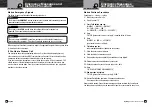
49
Nothing
Comes Close to a Cobra
®
VHF Marine Radio Procedures
VHF Marine Radio Procedures
•
Maintain Your Watch
Whenever your boat is underway, the radio must be turned On and be tuned to Channel 16
except when being used for messages.
Power
Try 1 watt first, if the station being called is within a few miles. If there is no answer,
switch to 3 watts and call again. You have the ability to go up to 6 watts of output power
to increase your calling distance. Remember, the lower wattage outputs will conserve your
battery and minimize interference to other users.
Calling Coast Stations
Call a coast station on its assigned channel. You may use Channel 16 when you
do not know the assigned channel.
Calling Other Vessels
Call other vessels on Channel 16 or on Channel 9. (Channel 9 is preferred for recreational
vessel use.) You may also call on ship-to-ship channels when you know that the vessel is
listening on a ship-to-ship channel.
Initial Calling on Channel 16 or 9
The use of Channel 16 is permitted for making initial contact (hailing) another vessel. The
limits on calling must be followed. Be reminded, Channel 16’s most important function is
for Emergency Messages. If for some reason, Channel 16 is congested, the use of Channel
9, especially in U.S. waters, may be used as the initial contact (hailing) channel for non-
emergency communication.
Limits on Calling
You must not call the same station for more than 30 seconds at a time.
If you do not get a reply, wait at least two (2) minutes before calling again.
After three (3) calling periods, wait at least 15 minutes before calling again.
Change Channels
After contacting another station on a calling channel, change immediately
to a channel which is available for the type of message you want to send.
Station Identification
Identify, in English, your station by your FCC call sign (if available), vessel name and the
state registration number, at both the beginning and at the end of the message.
VHF Marine Radio Protocols
48 English
VHF Marine Radio Procedures
Introduction
VHF Marine Radio Protocols
VHF Marine Radio Protocols
Prohibited Communications
You
MUST NOT
transmit:
n
False distress or emergency messages.
n
Messages containing obscene, indecent or profane language.
n
General calls, signals or messages (messages not addressed to a particular station) on
Channel 16, except in an emergency or if you are testing your radio.
n
When you are on land.
















































